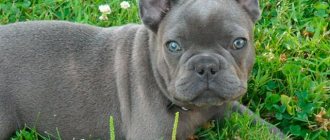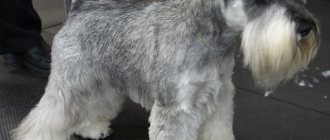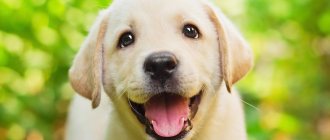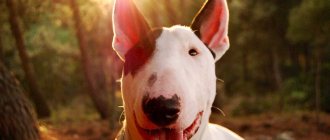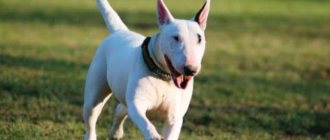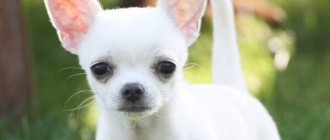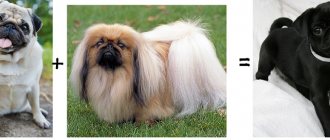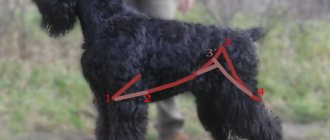The Bull Terrier dog breed has never been popular. But everyone recognizes this dog with an unusual appearance. Among people unfamiliar with the breed, he has a reputation as a killer dog, vicious and dangerous. But in fact, this is a faithful companion, affectionate and gentle with all family members. He is not angry, very playful and calm.
- Head and muzzle
- Why is a bull terrier dangerous?
- Walk
Breed traits
Breed traits (on a 5-point scale)
| Bull Terrier | |||
| Activity | in the house | 2.7 | |
| on the street | 4.3 | ||
| Obedience | training | 3 | |
| strangers | 4 | ||
| Domination | in family | 3.3 | |
| over dogs | 2.3 | ||
| Defending your territory | from people | 3 | |
| from dogs | 2.7 | ||
| Sociability | in family | 4.7 | |
| with strangers | 3 | ||
| with dogs | 3 | ||
| Concentration | in family | 1.3 | |
| in front of strangers | 2 | ||
| with dogs | 2.7 | ||
| Aggressiveness | in family | 2 | |
| to strangers | 2.3 | ||
| to the dogs | 2 | ||
| to cats | 1.7 | ||
| Family behavior | calmness | 3.3 | |
| demand for affection | 3.3 | ||
| excitability | 3.7 | ||
| playfulness | 4 | ||
| excessive barking | 2 | ||
| behavioral breakdowns | 1.7 | ||
| Tolerance for children | up to 4 years | 3 | |
| over 4 years old | 3.3 | ||
| Institutional use | watchman | 3.7 | |
| bodyguard | 3.7 | ||
This breed is often compared to the following dog breeds: Doberman Pinscher, American Staffordshire Terrier, French Bulldog, German Shepherd, Rottweiler.
A negative opinion arose due to the fact that the bull terrier was bred as a fighting dog. The breed's reputation suffered even more in the 90s, when newbies adopted these difficult-to-train dogs. They couldn't cope with their upbringing, and an uncontrollable, angry dog grew up. To understand what a breed actually is, you need to study its description, the pros and cons of its content, and reviews from owners.
Bull Terriers are easily recognizable in the photo:
White color
Brindle color
Rottweiler
Rottweiler / Photo: Pixabay.com
Another service breed bred in Germany. It is used by security guards, police officers, and dog handlers. Rottweilers are highly trainable, but it must be done professionally. An inexperienced breeder risks not being able to cope with these creatures.
If the dog is not given constant attention, left to his own devices, he will certainly be dangerous. In this case, dogs become aggressive and cruel—cats and other animals are at risk, but people are also at risk.
Characteristics of bull terriers
In terms of popularity among famous breeds, bull terriers are now in 42nd place. In every country there are lovers of the breed who consider it the best for home keeping. This is a truly unusual dog, difficult to train. She has a memorable appearance and an unusual character. She can become a faithful companion, a cheerful playmate for a child. According to many owners, the Bull is a sissy and a sleepyhead, affectionate, touchy and vulnerable. But the reputation of a dangerous, evil killer did not arise out of nowhere.
The Bull Terrier is not a breed for everyone. He has a complex dominant character. Independence and stubbornness require serious education and timely socialization. Not every dog breeder can handle such a dog. If you raise a Bull Terrier incorrectly, its strength, developed intelligence, fearlessness and endurance, which are inherited from its ancestors, can cause problems.
| Options | Characteristic |
| country of origin | Great Britain |
| time of appearance of the breed | 19th century |
| group of breeds under the ICF classification | terriers, bull terrier section |
| height | 53-55 cm |
| weight | 23-32 kg |
| life expectancy | 11-14 years old |
| purpose of the breed | companion |
| aggressiveness | not aggressive |
| activity | very high |
| intelligence | smart |
| training | complex |
| attitude towards loneliness | can't stand it |
| care | simple |
The advantages of these dogs
According to fanciers, bull terriers are the best pets. They have many advantages in character, behavior and content features:
- friendly, loving, gentle, love children;
- active, hardy, cheerful and playful;
- loyal, ready to protect the owner from any threats;
- smart, quick-witted, easily understands commands;
- due to their small size they get along well in a city apartment;
- require minimal care, are unpretentious and clean.
Minuses
But when getting such a dog, it is important to understand that the bull terrier is an unusual dog. You need to immediately prepare for the fact that others are biased towards the breed. Many people get scared and demand that the dog be muzzled or removed from the dog park. But this is not the only drawback of the breed. Before getting a bull terrier, you need to pay attention to the following disadvantages:
- They become very attached to their owner and cannot stand loneliness;
- prone to dominance, without strict upbringing they become uncontrollable;
- They can make a lot of noise, fuss, chew things out of boredom, are capable of crumbling a chair, tearing off linoleum;
- jealous, do not get along well with pets, can hunt cats, are aggressive towards dogs;
- they require active walks and high physical activity;
- lack guard qualities, since they have no malice towards people;
- They cannot tolerate frost, and white dogs can get burned in the bright sun.
Who can and cannot have dogs of this breed
Bull Terriers are very active, inquisitive and intelligent. The breed is perfect for people who lead an active lifestyle and can spend a lot of time with their pet. Bull Terriers cannot stand loneliness and constantly require attention. The owner must understand the characteristics of this breed and know the rules of training. It is not recommended to have this dog for families who are planning to have a child, as they are jealous and touchy and require a lot of attention. The Bull Terrier will never become a calm and obedient lap dog. The following people should also not have a breed:
- physically weak - girls, pensioners, children;
- hot-tempered, unbalanced;
- unable to gain authority or show firmness;
- for beginners who do not understand how to behave with such a difficult dog to train.
Often professional breeders meticulously choose a new owner for puppies. They try to prevent the dog from developing fighting qualities, so that improper training turns it into an uncontrollable, angry dog. Interesting video about the advantages and disadvantages of bull terriers:
Socialization
English bull terriers are not recommended for older people. Families with children should be careful - if the dog is poorly socialized, clashes due to jealousy cannot be avoided. Plus these dogs don't like to be teased. Sometimes the games and behavior of children are interpreted by animals as a challenge, and they respond accordingly.
Therefore, a bull terrier and children under 10 years old are not the best company. Toddlers do not yet know how to properly handle a dog, and the dog is rarely careful during games. He can push or knock down a child - such an event, given the remarkable strength of the pet, entails disastrous consequences.
Bull Terriers get along well with children of middle school age. They are strong and durable enough to withstand sometimes wild games.
But relations with other pets are worse than ever. There are English Bull Terriers that tolerate the company of other dogs and cats. The key word is patience. They will not become friends, but will only learn to coexist peacefully.
A dog will never get along with birds and rodents. A hamster brought into the house will live for 3 minutes at most.
Plus, the characteristics of the breed include a tendency to dominate. Bullies try to push cats, dogs and even family members to the bottom of the hierarchical ladder. And towards other males they are completely aggressive. You should avoid the company of other people's dogs when walking: even a muzzle will not save you from a fight - bull terriers tear it off in half a second.
History of the origin of bull terriers
The ancestors of bull terriers are dogs that were used for fighting. In the Middle Ages, bloody sport was popular in England - they set dogs against large animals: bulls, bears, wild boars. There was a fighting pit in every English village. Strong, angry, hardy and fast small dogs were used for fighting. They were specially selected from English bulldogs.
After a law prohibiting bullfighting was passed at the beginning of the 19th century, lovers of this bloody spectacle switched to dogs. Fighting breeds began to be bred, more active and agile. The result was the Bull and Terrier, which combined the ferocity and powerful grip of the Bulldog with the energy of the Terrier. They were ready to fight to the bitter end, did not feel pain, and their bites were often fatal.
The modern bull terrier breed appeared in the middle of the 19th century. The breeder was James Hinks. He tried to improve the external characteristics of the bull and terrier, to breed a more attractive dog. English bulldogs, white terriers, Amstaffs, even greyhounds and Dalmatians were used in the selection. Compared to the Bull and Terrier, the new breed had an elongated head, a long body, and the dewlap on the neck and folds of skin disappeared. The result was an elegant, unusual dog with developed intelligence. But she still has the traits of fighting breeds:
- powerful jaws that cannot be unclenched; the bite creates a pressure of 25 atmospheres;
- ferocious character;
- excellent response;
- small strong body;
- perseverance and perseverance;
- strength, endurance.
At that time, bull terriers were white; other colors were not allowed. The new breed was recognized at the end of the 19th century and became popular. At the beginning of the 20th century, amateur clubs began to be created around the world. This dog went from being a fighting dog to being a companion. But the history of the new breed had many problems. At first, crossing white individuals with colored individuals was not allowed. This almost brought the breed to the brink of destruction - white dogs began to be born with genetic diseases. Then the ban on ear cropping forced breeders to look for a way to make them stand up. And now in some countries this breed has been completely banned. These are Germany, Ireland, Switzerland, Spain, Israel.
Bull terriers are not prohibited in Russia. The breed became popular in the 90s, but immediately acquired a negative reputation. This is due to the fact that these dogs were bred by inexperienced dog breeders. They were raised incorrectly, even set against them. Therefore, many people have the opinion that the bull terrier is an angry dog that is inadequate and can attack at any moment. Interesting historical pictures showing the characteristics of bull terriers:
Historical photo
Historical photo
Interesting Facts
Like all long-known dogs, bull terriers have accumulated a sufficient baggage of all kinds of stories from the life of the breed. The most interesting facts about bull terriers:
- In the 1980s, the dog of this breed became a screen star. Bulpo nicknamed Mackenzie starred in a commercial for Budweiser beer and immediately gained millions of fans.
- Stories that dogs of this breed have a “death grip” are fiction. As a result of the research, experts found that the boule does not have such a physiological feature.
- Among Oxford students and teachers, it has long been considered prestigious to own a dog of this particular breed.
- There are several closely related breeds, among which the Gull Terrier deserves special attention. This dog is better known as the Pakistani Bull Terrier. It differs from the English Bull Terrier in the shape of its head and tall stature.
- The bite of a bull terrier is measured in kg/cm2. The force of compression of a dog's jaws can reach about 140 kg/cm2.
Expert opinion
Leonid Rodin
Experienced dog breeder
Ask a Question
The legendary bull terrier Patsy Ann was completely deaf and lived on the street. And she became famous for the fact that, in search of food, she unmistakably identified the piers where ships would moor in the near future. This talent was noticed by people, for which the bull terrier in 1934 received the honorary title of “official greeter” from the city administration. Based on the dog’s behavior, local residents quickly learned to navigate which pier the ships would moor at and, together with Patsy Ann, went out to meet the sailors. This amazing dog lived until he was 13 years old. At the end of his life, he was already tormented by rheumatism and was overweight, but the habit of meeting ships remained until his last day. In 1992, half a century after her death, a bronze sculpture of Patsy Ann was installed in the port of Juneau - on the very pier that became famous thanks to the abilities of this bull terrier. And inside the casting there is dog hair, cut from different dogs around the world - a symbol of a single spirit that unites all faithful and devoted four-legged friends of man.
Description of the appearance of representatives of the bull terrier breed
Due to isolated cases of bull terrier attacks, many people know what they look like. This dog has an extraordinary appearance, not for everyone. Sometimes it is compared to a rat or a pig. But lovers even consider her beautiful. The Bull Terrier has an elegant, robust body of medium size. He is agile and muscular. The main characteristic of its appearance is its egg-shaped head; this shape does not exist in other breeds. Therefore, the Bull Terrier is a unique dog. At first glance, one gets the impression of a dangerous, strong animal. The standards do not limit the size of a bull terrier. The main thing is that the dog must be built harmoniously; the correct ratio of height and weight is important.
Most breeders recognize the standard height at the withers for bull terriers as 45-55 cm. Bitches are usually slightly smaller. The standard also does not indicate how much this dog should weigh. The average weight of a bull terrier is about 30 kg, but a female dog should have a little less - up to 25 kg. It is important that the dog does not look fat or too graceful. The description of the appearance features of these dogs can be supplemented with photographs:
Appearance
Appearance
Head and muzzle
The unusual head is the main feature of bull terriers. It is long, large and low set. When viewed from the side, it is egg-shaped. In the upper part it is curved in the form of a gentle arc, descends towards the nose, but is flat between the ears. The nostrils are large, open, and should be black. The lower jaw is strong, tenacious, cheekbones are clearly expressed, there are no jowls. Scissor bite, teeth are even and strong. The eyes are dark, narrow, triangular in shape, set obliquely and deeply. Located closer to the top of the head, far from the nose. The look is decisive, self-confident. The Bull Terrier's ears are small, triangular, and elongated. Set high on the head, close to each other. The ears are mobile and held vertically. In pictures of a bull terrier you can recognize it by its special head:
Head
Head photo
Body type
The Bull Terrier's height is not high, it should not exceed 35 cm. The physique is muscular, the torso looks round and squat. The neck is thick, the same width as the head, widening towards the shoulders. Strong and mobile, without skin folds. The chest is deep and low. The chest is wide, the ribs protrude. The abdomen is slightly raised, but not very tucked. The back is short, strong and straight. The croup is slightly sloping. The standard tail is of medium length, straight, tapering towards the end. Set on high, the dog usually holds it horizontally. If she is excited, the tail moves actively.
Limbs
The limbs are muscular, straight and parallel. The shoulder blades are pressed to the chest, the elbows are directed back. The hind legs are strong and widely spaced. Bull Terriers have large hips, flexible knees, and well-developed hocks. The paws are round, compact, and the toes are mobile. The dog moves freely, easily, with its legs parallel. Photos show the body features of bull terriers:
Body type
Body type
Bull Terrier Coat and Colors
The coat is short, hard, shiny. Dries quickly and is easy to comb out. The undercoat appears only during cold weather. Shedding is light, twice a year. The skin fits tightly to the body and does not form folds. The standard allows several color options. The most common bull terriers are white. In such dogs, colored spots and skin pigmentation are acceptable on the head. Brindle bull terriers are now popular, although this color was not previously recognized. Typically this coloring is a red coat with black stripes.
Sometimes there are black, red, brown ones, always with white spots on the chest and paws. The area of such marks should not exceed 50% of the body surface. A mixture of three colors is also possible: white, black and red. Among all colored representatives of the breed, the brindle color is preferable. The standard does not recognize sand, blue and white spots. The photo shows a dog of the popular brindle color:
Brindle color
Brindle color
Varieties
Nowadays there are several varieties of bull terriers. They are not recognized by the standard, but these dogs have lovers. They are not very different from the standard representative of the breed:
- bulldog type with a larger skull, wide muzzle and dense build;
- terrier type with light bones, compact and agile dogs;
- Dalmatian is tall-legged, with an elongated head;
- dwarf or mini bull up to 35 cm tall, weight up to 15 kg.
Disqualifying faults
The breed standard has changed several times. The modern version has retained the special features created at its inception. He is strict about their preservation. Therefore, if there is the slightest deviation, the dog is not allowed to be bred. The following disqualifying defects are often encountered:
- a long tail;
- incomplete pigmentation of the nose and lips;
- cowardice, aggressiveness;
- arched back;
- weak muscles;
- malocclusion;
- light eyes.
Undesirable colors
It happens that puppies with a special color are born in a litter, which is not recognized by breed standards. However, dogs with undesirable colors still have names:
- gray bull terrier;
- sand;
- blue;
- dark chestnut.
Today, bull terriers of such colors are quite rare and are usually considered a sign of a non-purebred dog. But despite this, they also have the right to exist.
The color of a bull terrier is, of course, important when buying a puppy. The choice of animal color depends entirely on the preferences of the owner. If the owner is going to exhibit his pet at shows, he should not take a puppy of a non-standard color.
White dogs look less menacing. Their black counterparts are striking in color and create a more intimidating impression. The tricolor coloring will always arouse the genuine interest of others. Which dog to choose - plain or colored - is an entirely individual question.
But in any case, it is necessary to remember that a bull terrier of any color must be properly raised and competently trained. Only in this case will the fighting dog turn into a devoted friend and true protector.
Character and habits of bull terriers
Despite their reputation, Bull Terriers are good-natured, cheerful dogs. A study by the American Canine Association found that only 10% of the breed retained the fighting qualities of their ancestors and can pose a danger to humans. The rest, with proper socialization and strict upbringing, become lovely pets. Problems arise due to improper behavior of owners.
A dog should not be allowed to bite people or other animals; it is even more prohibited to bait bulls or develop fighting qualities in them. An improperly trained dog can even bite its owner. And with the strength of his teeth, this can lead to serious injury. These dogs also have a developed instinct of pursuit. Therefore, they can attack other animals. Bull Terriers are highly active even in adulthood. The dog is ready to play and run around the clock. Pets love to accompany their owner when running and cycling. If you don't give your dog exercise, he will throw out energy at home and can cause damage to the environment.
A dog's behavior greatly depends on its upbringing. Each breed has temperamental characteristics that need to be taken into account. Bull Terriers are characterized by hyperactivity, autonomy, and independence. They are willful, touchy and vulnerable, and may be jealous or suffer from depression. But besides the negative qualities, the character of bull terriers has many positive traits.
- Representatives of the breed have a stable psyche. They are not shy, not aggressive. If the beloved owner is nearby, the dog will be calm in any environment.
- These dogs have a sense of humor. They can make the owner laugh and cheer him up. And the structure of the muzzle is such that the dog can smile.
- The Bull Terrier is a good-natured, friendly pet, not at all angry. He loves people and greets guests joyfully.
- This is a devoted dog, he loves his owner very much. Accompanies him everywhere, misses him. This is the perfect companion.
These dogs love children and enjoy playing with them. The main thing is that adults are nearby, as the bull can accidentally push the child, because he is quite clumsy. He also does not tolerate being teased or hurt. The child must be old enough to understand how to behave. After all, even a slight bite from this dog can be dangerous. The video shows that these dogs are cute, good-natured and cheerful:
Why is a bull terrier dangerous?
The negative reputation of bull terriers appeared due to unscrupulous breeders. When these dogs became popular, kennels started breeding them without caring about their temperament. Breeders did not pay attention to the selection of individuals with a stable psyche and lack of aggression. And owners often cultivated fighting instincts. From their ancestors, representatives of the breed inherited qualities that can make them dangerous.
- A tenacious grip of powerful jaws that is difficult to release. This dog can hold a bite for up to 3 hours. You can force him to release his grip by holding ammonia to his nose.
- The Bull Terrier's build is strong and muscular. He is very dexterous, agile, moves easily and actively. Moreover, it can cause pain even when showing tender feelings to the owner, since it does not have delicacy.
- This dog is hardy and stubborn, capable of making independent decisions. Can rush at a person whom it considers a threat. And if the dog starts something, he won’t back down. For this reason, you should not train bull terriers or give them the “front” command.
- The desire to win and the willingness to fight to the end. The Bull Terrier will fight bravely against an opponent stronger than him. These dogs are insensitive to pain.
Many people confuse the Bull Terrier with similar breeds. These are the American Staffordshire Terrier, the English Staffordshire Bull Terrier, and the American Pitbull. It is the latter breed that is dangerous and prohibited for breeding in many countries. Pit bulls are aggressive, fearless, and can attack at any time. And bull terriers rarely make it into the rankings of the most aggressive dog breeds.
Pet habits
The Hulk has a huge and at the same time incredibly kind heart - he loves to play with the sons of his owners, hug with Marlon and Lisa, and sing to the sound of a harmonica.
At the same time, such a good-natured expression is reflected on the dog’s face that, having seen at least one of his photographs, it is impossible not to fall under his incredible charm and not become one of the most devoted fans of this amazing beast.
IMPORTANT!
To maintain muscle tone and obtain the required amount of energy, Hulk must eat a lot of protein foods.
Typically, his daily menu consists of two kilograms of ground beef, to which some chopped vegetables, fruits or dairy products are added. In addition, the owners feed the world's largest pit bull with high-quality dry food.
Education and training
Bull Terriers are stubborn and headstrong dogs. They will not obey unquestioningly, especially to a weak-willed and weak person. This dog often behaves like a capricious child. It is necessary to show patience, persistence, and consistency in education. But an experienced owner will have a bull terrier that is obedient and affectionate. His high intelligence and quick wit make him an ideal pet. But only if a person can gain authority and immediately show who is boss in the house. Bull Terriers are very smart, independent, and willful. They quickly understand commands, but do not always follow them. To achieve obedience from a dog, you need to take the position of leader from the first day the puppy appears in the house and define the boundaries of what is permitted:
- teach to share toys, allow the owner to take food;
- immediately stop any aggression;
- You should not be allowed to sleep on a bed or walk in the door in front of a person;
- you cannot indulge whims and forgive pranks;
- It is important to reward correct behavior with treats;
- Do not allow cats to be chased or fights with dogs;
- You cannot force a dog to do something, its stubbornness is difficult to overcome, this will only lead to a loss of authority.
Any incorrect behavior must be responded to immediately and strictly, but not with physical punishment. It is important that all family members adhere to the same rules in education. From an early age, a dog needs socialization. She should not react aggressively to changes in the situation or to strangers. A small puppy must be introduced to loud sounds, car noise, and other animals. This will help avoid problems as he gets older. The peculiarity of training this dog is that it has scattered attention. It will take some effort to get your pet interested. Classes should take place in a playful environment and last no more than 10-15 minutes. Training can be time-consuming, but it is necessary, otherwise the Bull Terrier will become uncontrollable. This video will help you learn how to properly raise this dog:
American Staffordshire Terrier
American Staffordshire Terrier / Photo: Pixabay.com
With this hero of today’s top, the situation is the opposite - no one doubts his danger. It is clear from the dog that it is capable of much - its powerful muscular body, fangs, and mobility reveal the dog as a potential killer.
Staffordshire Terriers are fearless fighters with a high pain threshold. Bred to guard and protect the owner, they bravely rush at the enemy, and show friendliness only towards the owner.
Caring for Bull Terrier dogs
Bull Terriers are dogs that do not require much grooming. You need to bathe 2-3 times a year, but wash your paws after a walk. Short wool, if it becomes dirty, can be wiped with a damp cloth. There is also no need to comb it often; this is done 1-2 times a week using a special mitten or a stiff brush. During molting - daily. You should regularly examine your pet's eyes and ears. If necessary, wipe them with a cotton swab dipped in veterinary lotion. It is also recommended to brush your teeth several times a week with a special paste to avoid the formation of tartar. If the claws do not grind down on their own, they are trimmed every month with a nail clipper.
Walk
The Bull Terrier will become the best pet only if you provide it with long walks and physical activity. He needs jogging, outdoor games, the dog loves to run after a ball or Frisbee, and accompany the owner when riding a bicycle. During walks, the bull terrier must be on a leash. And in crowded places or on dog parks, it is advisable to put a muzzle on him. Even a well-mannered dog can lunge at a person or another dog if it feels a threat to itself or its owner. And since he is strong and agile, it is not always possible to hold him. Photos of bull terriers on a walk:
On a walk
We're walking
Diet
You can feed your bull terrier natural food or dry food. The diet must be selected carefully, only fresh foods should be given; these dogs often have allergies and indigestion. The main place in the diet should be lean meat, preferably raw, which is doused with boiling water. It is also important to give offal, cereals, vegetables, vegetable oil, sea fish, eggs, and dairy products. Veterinarians recommend adhering to the following rules:
- always feed at the same time;
- do not give food from your table or a lot of treats;
- dogs fed natural food need to add vitamins to their food;
- Do not give chocolate, smoked meats, fatty and spicy foods, baked goods, sausage, nuts;
- if the pet refuses to eat, you need to change the diet; bull terriers are capricious in their choice of food;
- Change your diet gradually; you cannot combine natural food and dry food.
If your dog is fed industrial food, you should give preference to the premium and super-premium class. Suitable foods are Royal Canin, Acana, Brit Care, Probalance, intended for medium breed dogs.
Health
If you create normal conditions for your pet, he will live 13-14 years without illness. These are healthy dogs with almost no congenital pathologies. Sometimes found:
- joint dysplasia, especially affecting the elbows and knees;
- entropion of the eyelids, inflammatory eye diseases;
- atopic dermatitis;
- congenital deafness;
- epilepsy.
With the wrong choice of diet or unsuitable living conditions, bull terriers can suffer from allergies, obesity, and indigestion. These dogs are susceptible to colds, as they do not tolerate cold well, and individuals with white fur may develop sunburn. It is also important to carry out timely vaccinations and treat your pet against parasites.
Health
The British Bull Terrier is hardy and strong. But it is characterized by breed diseases. Therefore, on average, a bull terrier lives 10-12 years.
Diseases
The characteristics of the breed include the dogs’ tendency to:
- congenital deafness – typical for white dogs;
- elbow dislocations;
- mastocytoma;
- polycystic ovary syndrome;
- inversion and eversion of the eyelids;
- dermatitis and demodicosis;
- aortic stenosis;
- dysplasia;
- epilepsy.
Allergies, obesity, and skin pathologies due to improper feeding are common. Light-colored dogs are more susceptible to dermal diseases.
Preventive measures
Bull Terrier puppies are sold early - at 2, sometimes 1.5 months. Therefore, all vaccinations are done by the owner. The schedule and list of required vaccines is compiled by the veterinarian for each dog separately. The approximate diagram is as follows:
- at 8 weeks - a drug for distemper, parvovirus, hepadnavirus, coronavirus, parainfluenza, leptospirosis;
- at 11-12 weeks - revaccination;
- at 4-6 months – rabies vaccination;
- at 12 months and then annually - a comprehensive vaccine against all viruses.
The Bull Terrier breed does not tolerate insect poison well. Even a mosquito bite can cause severe allergies. Therefore, once every 2-3 months it is necessary to carry out antiparasitic treatment against ticks, lice, fleas and helminths. In spring to autumn, collars with repellents and insecticides are recommended.
Bull Terrier puppies
It is better to purchase bull terriers from well-known kennels. The largest ones are located in Moscow, but in other cities of Russia you can also buy a purebred puppy. Its price is 30-40 thousand rubles. A show-class puppy from multiple exhibition winners costs at least 70 thousand. It is not recommended to buy a bull terrier without a pedigree from advertisements or on the market. In most cases, mestizos show aggression. And responsible breeders do not allow individuals with unstable psyches or genetic abnormalities to breed.
In addition to documents and a veterinary passport, they give the new owner their phone number. And they always help with advice on feeding, care and education. When choosing a puppy, you need to pay attention to its behavior and appearance. It should be well-fed, but not fat, the coat should be smooth and clean, the nose should be wet and cold. There should be no discharge from the eyes or ears, bloated abdomen, or dandruff. It is important that the puppies are kept in normal conditions and are active. It is recommended to choose the most curious baby. Before buying, you need to check his hearing; bull terriers often suffer from congenital deafness. Photos show what bull terrier puppies should be like:
Puppies
Photos of puppies
Some more interesting photos of representatives of this breed:
Bull Terrier with a child
Bull Terrier with children
The Bull Terrier is an unusual breed of dog. It is not suitable for everyone. A strong, active dog with a fighting past can cause a lot of problems if improperly trained. But if you manage to gain his authority and teach him how to behave, he will be a cheerful companion and a loyal friend.
Caucasian Shepherd Dog
The Caucasian Shepherd is a dangerous breed. The original task of the species was to protect grazing livestock from large predators.
The dog is distinguished by loyalty and an innate instinct to protect the pack. She will fiercely protect herself and anyone she considers family (even cats). But there is a high chance that she will attack any stranger, even if it is the child of guests who came to visit you.
Caucasian Shepherd: Wikipedia
The American Dog Fanciers Club describes the Caucasian Shepherd as fearless, self-confident and fierce if she or her family is threatened.
